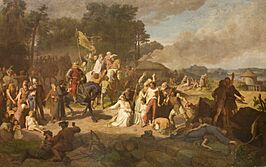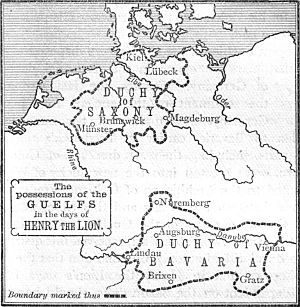Wendish Crusade facts for kids
Quick facts for kids Wendish Crusade |
|||||||||
|---|---|---|---|---|---|---|---|---|---|
| Part of Northern Crusades | |||||||||
 The Capture of the Wends |
|||||||||
|
|||||||||
| Belligerents | |||||||||
|
Wendish allies:
|
||||||||
| Commanders and leaders | |||||||||
|
|
||||||||
The Wendish Crusade (German: Wendenkreuzzug) was a military campaign in 1147. It was part of the Northern Crusades. This crusade was mainly led by the Kingdom of Germany within the Holy Roman Empire. Its target was the Polabian Slavs, also known as "Wends".
The Wends were Slavic tribes like the Abrotrites, Rani, Liutizians, Wagarians, and Pomeranians. They lived east of the River Elbe. This area is now parts of northeast Germany and Poland.
The lands where the Wends lived were very rich. This was a big reason why people joined the crusade. The Baltic area had a mild climate, good for farming and raising animals. Animals there had thick fur, which was important for trading. Being near the coast also helped with fishing and trade. The land was appealing because of its resources. The crusade offered a chance for noble families to gain some of this valuable land.
By the early 1100s, German church leaders wanted to convert the nearby pagan West Slavs to Christianity. They hoped to do this peacefully. But during the preparations for the Second Crusade to the Holy Land, the Pope issued a special order. This order supported a crusade against these Slavs. The Slavic leader Niklot attacked Wagria in June 1147. This led to the crusaders marching later that summer.
The crusaders forced some Slavs to be baptized at Dobin. However, they were pushed back from Demmin. Another crusader army marched towards Szczecin, a city that was already Christian. When they arrived, the crusaders broke up. The Christian army was mostly made up of Saxons and Danes. They made the pagan Slavs pay tribute. They also made sure Germany controlled Wagria and Polabia through new settlements. But they did not manage to convert most of the people right away.
Contents
Why the Crusade Happened
In the 900s, the Ottonian dynasty of the Holy Roman Empire wanted to expand east. They aimed for the lands of the Wends. King Henry the Fowler and Emperor Otto the Great led campaigns. They set up forts called burgwards to protect German gains. Church leaders also set up bishoprics to manage the new areas.
Most Wendish tribes had become Christian after German conquests. But in 983, a big Slavic rebellion happened. The Wends went back to their old pagan beliefs. The Germans lost control of some areas, and the Elbe River became their eastern border again.
By the early 1100s, church leaders wanted to convert the pagan Slavs peacefully. Missionaries like Vicelin tried to help. But German princes wanted Slavic land. They often fought with the Slavs. Christians, especially Saxons, and pagans raided each other's lands. They usually did this to get tribute.
The idea of a crusade against the Wends appeared in a letter from Magdeburg around 1107-1110. The letter said the Wends were pagans. It claimed any fight against them was right. It even called their land "our Jerusalem." The letter did not offer forgiveness of sins. Instead, it focused on gaining land. It said the Wends were "wicked," but their land was "the best." It was rich in food and animals. This promise of wealth was very appealing to those who wanted to gain land. This letter helped set the stage for the Wendish Crusade. It showed that gaining land would be a key goal.
From 1140 to 1143, nobles from Holstein moved into Wagria. They wanted to settle there permanently. Count Adolf II of Holstein and Henry of Badewide took control of some Slavic settlements. These later became Lübeck and Ratzeburg. Adolf made peace with Niklot, the chief of the Obodrite confederacy. He also encouraged Germans to settle and missionaries to work in Wagria.
The Pope's Call to Action
In 1144, the city of Edessa in Syria was captured. This shocked Christians in Europe. Pope Eugenius III and St. Bernard of Clairvaux called for a Second Crusade. This crusade was meant to help Christian lands in the Middle East. Many people from southern Germany volunteered for this. But Saxons from northern Germany were not so eager.
At a meeting in Frankfurt on March 13, 1147, the Saxons told Bernard they wanted to fight the Slavs instead. They saw the Wends as a threat to Christianity. So, a crusade against them seemed justified. Pope Eugenius III agreed to the Saxons' plan. On April 11, 1147, he issued a special order called the Divina dispensatione.
This order promised the same spiritual rewards for fighting the Wends as for fighting in the Middle East. This meant complete forgiveness of sins. People from Denmark, Saxons, and Poland volunteered. Some people from Bohemia also joined. Bernard of Clairvaux worried that some crusaders only wanted land. To make them focus on converting people, Bernard said: "We completely forbid any truce with these people. Do not make peace for money or tribute. Fight until, with God's help, their religion or their nation is destroyed." This condition was added to the Pope's order. The German king did not lead this crusade. It was led by Saxon noble families. The Pope's representative, Anselm of Havelberg, was in charge.
The War Begins
Niklot was angry about Adolf's part in the crusade. So, in June 1147, Niklot attacked Wagria first. He and the Wagrians destroyed new villages settled by Fleming and Frisian people. This led to the crusaders marching in late summer 1147. By attacking first, Niklot gave the crusaders more reason to fight. He made the Wends seem like a serious threat. After pushing the Obodrites out of his land, Adolf made a peace treaty with Niklot.
The remaining Christian crusaders then attacked two forts. One was the Obodrite fort at Dobin. The other was the Liutizian fort at Demmin.
The forces attacking Dobin included Danes led by Canute V and Sweyn III. Also there were Archbishop Adalbert II of Bremen and Duke Henry the Lion of Saxony. Niklot was good at defending the marshy land around Dobin. He avoided big battles. One Danish army was defeated by Slavs from Dobin. Another Danish army had to protect their ships from Niklot's allies, the Rani from Rügen. Henry and Adalbert kept up the siege of Dobin after the Danes left. Some crusaders wanted to destroy the countryside. But others disagreed. They asked, "Isn't the land we are destroying our own land? Aren't the people we are fighting our own people?" The Saxon army under Henry the Lion left after Niklot agreed to have the people in Dobin baptized.
The Saxon army that went to Demmin was led by several bishops. These included bishops from Mainz, Halberstadt, Münster, Merseburg, Brandenburg, Olmütz, and Bishop Anselm of Havelberg. Their main goal was to convert the pagans. But most also wanted more land and taxes for their church areas. Abbot Wibald of Corvey hoped to get the island of Rügen.
The Demmin campaign also included secular leaders. These were margraves Conrad I and Albert the Bear. They hoped to expand their territories. A group from Poland wanted to add land to the Bishopric of Lebus. Albert the Bear marched from Magdeburg. He took back Havelberg, which had been lost in the 983 Slavic rebellion. The crusaders then destroyed a pagan temple and a castle at Malchow. After failing to capture Demmin, some crusaders were sent by the margraves to attack central Pomerania. They reached Szczecin, a city that was already Christian. The crusaders then left after meeting with Bishop Adalbert of Pomerania and Duke Ratibor I of Pomerania.
What Happened Next
The Wendish Crusade had mixed results. The Saxons kept control of Wagria and Polabia. But Niklot still controlled the Obodrite land east of Lübeck. The Saxons also received tribute from Niklot. They were able to settle the Bishopric of Havelberg. Some Danish prisoners were also freed. However, the Christian leaders did not trust each other. The Danes, especially Canute and Sweyn, accused others of ruining the campaign.
Bernard of Clairvaux had said the crusade's goal was to fight the pagan Slavs. He wanted them to be "converted or deleted." But the crusade did not convert most of the Wends. Bernard had told crusaders not to make peace or accept tribute. But the crusaders did get tribute from Niklot. This made Bernard see the crusade as a failure.
The Saxons only achieved small, temporary conversions at Dobin. The Slavs went back to their pagan beliefs once the Christian armies left. Albert of Pomerania explained: "If they had come to strengthen the Christian faith... they should have done so by preaching, not with weapons." No Wendish priests were set up. No Christian books were translated into the Wendish language. Without these things, the forced conversions did not last.
The only successful conversions were made by the Danes. The Danes took back the island of Rügen in 1168. They were able to make it Christian again. They did this by building churches. They also allowed Prince Jaromit of Rügen to stay in power after he accepted Christianity. The Danes succeeded because they focused on encouraging Christianity. They did not just focus on controlling new land.
The Crusade was successful in gaining Slavic lands. It encouraged German settlers to move there. It also started a long series of crusades against the Wends that lasted through the 1100s. By the 1160s, most of the Wends were controlled by the Saxons or the Danes. However, in 1180, Henry the Lion and Emperor Frederick I Barbarossa had a disagreement. This allowed the Danes to gain more political control over the region. The Wendish Crusade had lasting effects. It helped expand political and colonial power in the Baltic area.
See also


